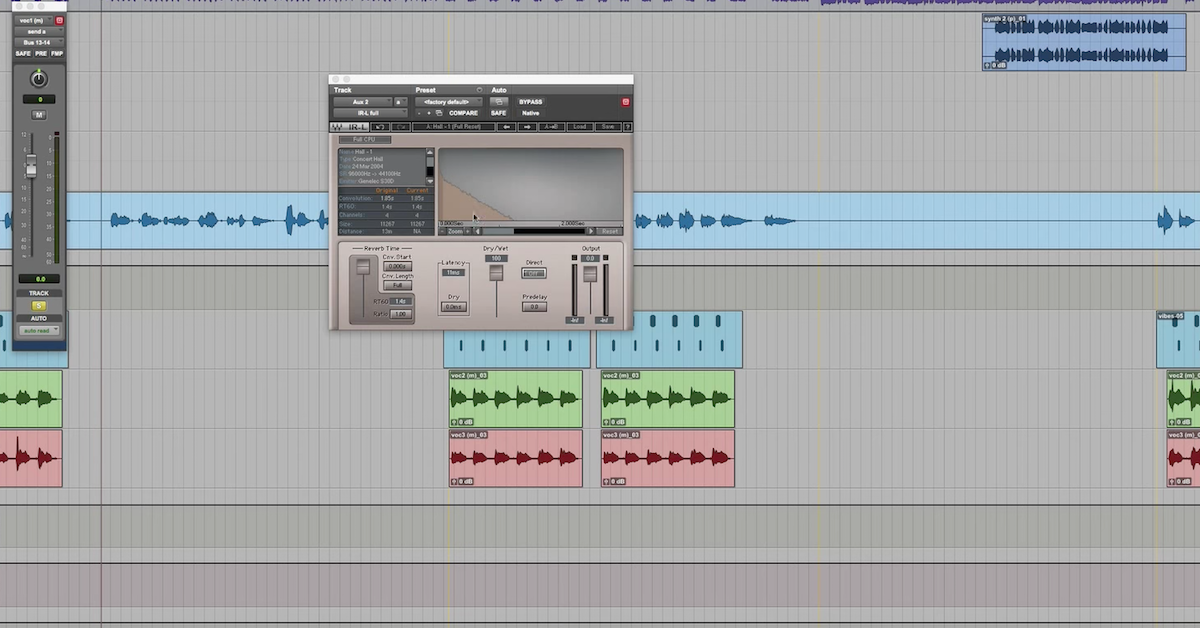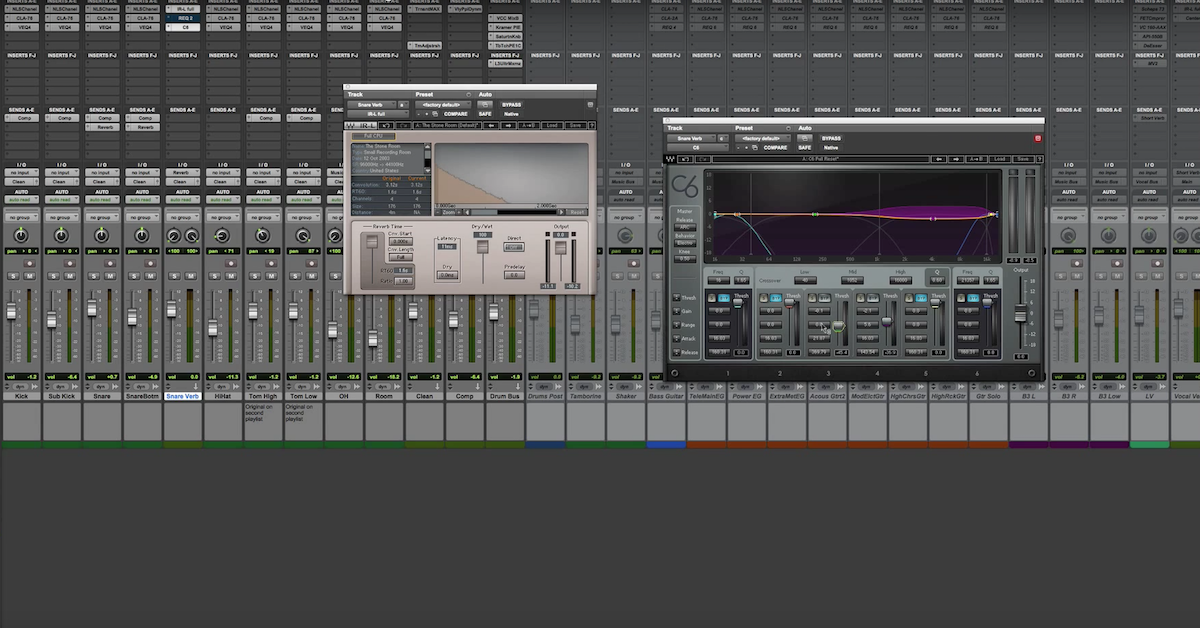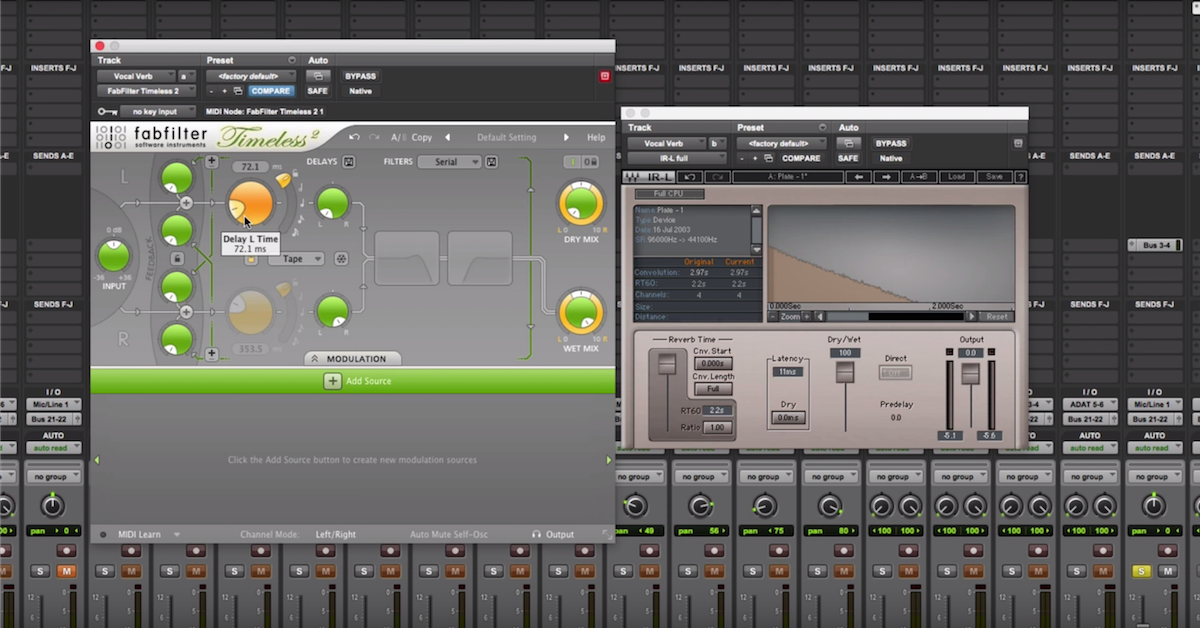Reverb Comparison: Convolution vs Algorithmic (Waves IR-L vs TrueVerb)
The two examples I’m gonna be showing you is the Waves IR-L which is a convolution reverb here. The other one is the Waves TrueVerb. This is an algorithmic reverb.
I’m gonna be using these plugins today on a multitrack drum session. I just want to use them to add a little bit of ambience to the tracks. So let me show you what’s going on with my session.
I’m using Addictive Drums and I’ve got it inserted over here on an instrument track. I’ve got the individual microphones from it: kick, snare, hi-hat, toms, overheads, rooms — I’ve got them bussed out to auxiliary tracks here. Then I went ahead on some of the different microphones and instruments I’m interested in sending to my reverb — opened up a send, and I’m just gonna take some of that signal, and put it down this auxiliary track: the reverb track. I’ve got IR-L and TrueVerb both inserted here, but they’re in Bypass right now. Let me play you backs hat my drums sound like without any reverb.
[drums]
Let me pull up some of these reverbs and give you an idea about how they sound. So I’ll start out — make sure that this is unmuted — I’ll bring it down and bring it in. I’ll start out with the IR-L and let you hear how that sounds.
[drums with IR-L]
Here’s I’ve muted the dry track so you can just here the reverb. Next I’m gonna go on to TrueVerb so you can get a sampling of what it’s doing.
[drums with TrueVerb]
So how are these plugins similar? Well, both plugins are designed to simulate the sound of a signal or instrument being produced in an acoustic space or an environment. This could be a hall, a room, a chamber — any sort of space, and the purpose of that is to give some ambience or room sound to whatever signal is being played.
Here I’ve really tried to bus out some of my snare drum and my kick drum to give them more of a feeling that they’re being played in a nice sounding recording studio or concert. Let me now focus on IR-L and talk about convolution reverb.
The main different between convolution reverb and algorithmic reverb is how the actual reverberation is created. This could be the echoes the delays the repeats. Those sorts of things. With IR-L — a convolution uses an impulse response. or an IR. An IR is a way of representing how a system changes a signal that passes through it. In this case, the system that we’re representing is an acoustic space or an environment.
The mathematical operation of putting a signal through a system is called convolution. So what happens inside of your DAW, is your signal gets convolved with the impulse response of the plugin. An impulse response is created by going into an acoustic environment with a speaker and a microphone and then playing some sort of signal like a sine wave sweep or a click or something like that. And then capturing that sound with a microphone. Ideally what you’d like to do is be able to provide an impulse that triggers the sound of the room and then the microphone captures it. However, due to limitations in how the kind of signal is capable of playing back, it’s popular to use things like sine wave sweeps to capture your impulse responses. But it’s something that even an amateur can do, you don’t have to be a plugin developer as large as Waves in order to create your own impulse responses. Many people can do it with just a speaker and the right kind of signal and a microphone.
Let’s get into controls of the convolution reverb. The main control that you have is over the reverb time. So right now I’ve got a plate loaded up and I’ll play it back and show you what happens if you play reverb.
[drums and reverb]
Hopefully you can hear that by changing the reverb time, it’s changing what the reverb sounds like. The main other way that you can change what your reverb is sounding like is just using a different impulse response, so rather than a plate here, we have a studio — I’ll bring that up — a room and a hall.
[drums and reverb]
Bring up another one. Lastly the hall. Really the only other thing that you can do with the convolution reverb is add a little bit of pre-delay. Starts to sound a bit unnatural if you get too far.
So really your flexibility and your ability to really change the sound and tailor it for your song is really dependent on the impulse response that you have in your library. So depending on which plugin you get, some of them have more impulse responses than other. The IR-L, it’s got four to choose from which is pretty good. And they all sound a little bit different. But really there’s that limitation to convolution reverbs is you’re really dependent on your impulse responses that you have.
Next let met all about an algorithmic reverb. With an algorithmic reverb, the actual echoes, delays, and repeats are not created by convolution with an impulse response. Rather, they can be created in a number of different ways which allows there to be many parameters that control the way that reverb is created. So you’ll see here, you have all kinds of different controls from room size, dimensions, distances, decay time. You have early reflections, and then you have the tail of the reverb, and all of these things are separate components of the reverb that you don’t have with the impulse response. So with an impulse response, you don’t have early reflections that you can control and you don’t have the tail. The early reflections are just kind of quick echoes that happen right after the signal is produced. And that really gives you the dimension of how large the space is. If echoes come really fast after the signal, then the room feels smaller but if they’re spread apart more than the room seems larger. So let me play you back some of these and show you how it sounds.
[drums with algorithmic reverb]
I’m gonna take out the early reflections. Just the tail. Or focus on the early reflections. Change the decay time. Density. Distance, all these sorts of things. Room size. So if you’re the kind of person that likes to really tailor your sound to the source and the song that you’re doing then an algorithmic reverb is gonna give you a lot more control.
Here you also have a fair amount of different presets to choose from. I’ll play you back some of these.
[drums with algorithmic reverb]
So what are the advantages and disadvantages? With an algorithmic reverb one of the advantages is it’s pretty computationally efficient. And a convolution reverb requires a lot more processing. So if you have a large session then using an algorithmic reverb might be better than a convolution reverb because you might weigh down your processor and it might not be able to run as many plugins. So another advantage of the convolution based reverb though is it sounds more natural than the algorithmic reverb.





